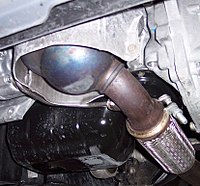
Photo from wikipedia
Abstract Dimethyl carbonate (DMC) is a promising alternative fuel for diesel engines. Comparing with the traditional diesel fuel, the DMC application can lead to a different combustion process where the… Click to show full abstract
Abstract Dimethyl carbonate (DMC) is a promising alternative fuel for diesel engines. Comparing with the traditional diesel fuel, the DMC application can lead to a different combustion process where the soot is synthesized, yielding variation in chemistry of engine-out soot particles. Soot chemistry is highly related to the concentration and accessibility of radical sites for the reactions regarding to soot oxidation on the exhaust systems or during DPF regeneration. Therefore, the study on the chemical feature of soot emissions is of great necessity. Nevertheless, comprehensive determination on the soot chemical property for DMC-contained fuel and its instinctive explanation is not well understood in the previous studies. In this study, to reveal the effect of DMC addition on the chemical feature of soot emissions, the surface functional groups and their bonding states of soot particles from various DMC-diesel blends were characterized using FT-IR and XPS technologies. Results showed that the DMC addition exerts different influences on the surface oxygen content, oxygenated groups and their bonding states with various DMC content. Therein, DMC addition in large amount can significantly increase the C sp3/sp2 ratio and the concentration of C-O epoxies on soot surfaces. At relatively low engine speed and load conditions, the low-content addition of DMC leads to slight increase in the aromatic C–H/aromatic C C ratio in soot bulk structure. However, the large-content DMC addition distinctly reduces the aromatic C–H/aromatic C C and aliphatic C–H/aromatic C C ratios. The results are useful for the prediction of the subsequent soot oxidation behavior during DPF regeneration on diesel engines.